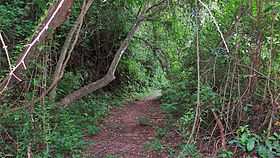Calilegua National Park
| Calilegua National Park | |
|---|---|
| Parque Nacional Calilegua | |
|
IUCN category II (national park) | |
|
El Pedemontano trail | |
 Location within Argentina | |
| Location | Jujuy Province, Argentina |
| Coordinates | 23°39′S 64°47′W / 23.650°S 64.783°WCoordinates: 23°39′S 64°47′W / 23.650°S 64.783°W |
| Area | 76,306 ha (763.06 km2; 294.62 sq mi) |
| Established | July 19, 1979[1] |
| Governing body | Administración de Parques Nacionales |
The Calilegua National Park (Spanish: Parque Nacional Calilegua) is a federal protected area in Jujuy Province, Argentina. Established on 19 July 1979,[1] it houses a representative sample of the Southern Andean Yungas biodiversity in good state of conservation.
Located at the Ledesma Department on the eastern slopes of the Calilegua hills. and with an area of 76,306 ha (763.06 km2; 294.62 sq mi), it is the largest national park in the Argentine Northwest.
History
This area was occupied a long time ago by native groups. Their settlements were located in the lower knoll, near the farming grasslands. The archaeological pieces and sites found in the park, such as pottery and polished stone axes, are related to the communities that inhabited the Yungas region. From the 15th century on, this territory was occupied by the Incas. At present, this region is inhabited by Kolla communities.
The park has a beautiful landscape, which you can see when transiting the Provincial Route 83 that runs through it. Along the route, you see three different environments: the jungle foothills, mountain forest and mountain woods, each with their own characteristic vegetation.
It is also possible to see certain species of birds and mammals in particular, which makes this site an ideal place to observe wildlife, especially birds, about 270 species were identified and its estimated that 230 more could inhabit the area, which makes Calilegua the home of 50% of all bird species in the country and a paradise for birdwatching. The park is home to the jaguar, the largest South American predator, along with other cats like the jaguarundi, the ocelot, the puma and the grasslands' cat. The largest mammal in the Yungas, the tapir, also inhabits the reserve.
Calilegua National Park and nearby towns offer a wide range of activities, with varying degrees of difficulty. The tours relate to ecotourism and active tourism, but the area offers a strong cultural imprint and you may visit several towns where the local contact is a highly valued experience for those interested in ethnic diversity and the discovery of local cultures.
See Also
References
- ↑ 1.0 1.1 Decreto No. 1733/1979, 25 de julio de 1979, B.O., (24213), 4 (in Spanish); prom.: 19 de julio de 1979
External links
- Administración de Parques Nacionales (Argentine National Parks Administration, in Spanish and English)
- Calilegua.com (Tourism information about Calilegua area in Spanish and English)
| ||||||||||||||||||||||||||||||||||
